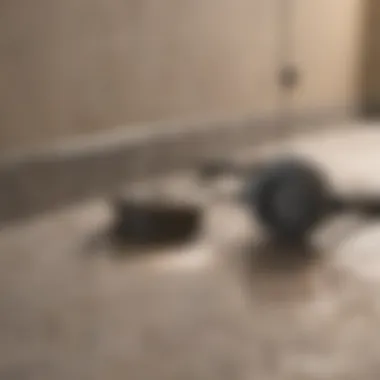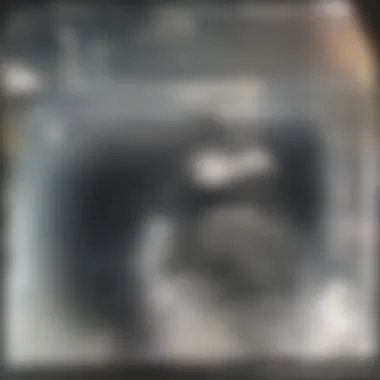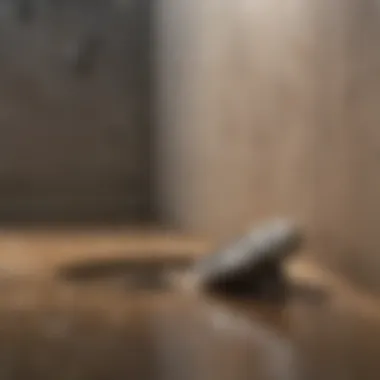Removing a Shower Drain: Essential Home Guide


Intro
Removing a shower drain is not simply a matter of unscrewing a few bolts; it often involves a nuanced understanding of plumbing systems and the challenges that arise during maintenance tasks. Homeowners might find themselves faced with issues like clogs, leaks, or wear and tear that necessitate removing the drain. This guide aims to demystify the process and provide straightforward methods to tackle it effectively.
Understanding the need for drain removal is key. Common reasons include replacing an old drain due to corrosion, addressing slow drainage caused by accumulated debris, or upgrading to a more aesthetically pleasing design. Each scenario carries its own set of challenges, making knowledge and preparation critical.
In the sections that follow, we will outline important tools, safety protocols, and a systematic approach for removing a shower drain. The goal is to equip you not just with the practical skills needed, but with a comprehensive understanding of the entire process. This way, homeowners can approach the task with both confidence and competence.
Intro to Shower Drains
Understanding shower drains is essential for homeowners and DIY enthusiasts. This section introduces the functions and types of shower drains, setting the stage for why one might need to remove or replace them. Shower drains play a critical role in maintaining hygiene by ensuring water does not pool and cause mold or other plumbing issues. A well-functioning drain removes water quickly and efficiently, adding to the overall comfort of the showering experience. Knowing the various kinds of shower drains helps in making informed decisions about maintenance and replacement.
Understanding Shower Drain Functionality
Shower drains work by funneling water away from the shower area and into the plumbing system. This is achieved through gravity, which directs the water flow towards the drain. If a shower drain is obstructed or poorly designed, water can accumulate, leading to unpleasant odors and potential damage to the flooring. Understanding how your shower drain operates is crucial for conducting effective maintenance. It also helps in recognizing signs that indicate a need for removal, such as slow drainage or unusual noises during water flow.
Types of Shower Drains
Knowing the types of shower drains allows homeowners to select the appropriate model for their needs. The design and function vary among different options.
Standard Floor Drains
Standard floor drains are the most common type found in residential showers. These consist of a circular grate that allows water to flow into a vertical pipe. The simplicity of this design makes it easy to install and maintain. It is a popular choice because it blends into the shower floor while effectively handling regular water flow. Key characteristics include the ease of access for cleaning and basic repairs. However, this design does have disadvantages; clogs can occur if hair and debris accumulate.
Linear Drains
Linear drains have gained popularity in modern bathrooms for their sleek appearance. They run along the edge of the shower, offering a more aesthetically pleasing look compared to standard drains. The key characteristic of linear drains is their capability to handle larger volumes of water, making them a great choice for larger shower spaces. Unique features include the versatility in design, where tiles can be used over the drain to blend it seamlessly into the floor. However, they can be more challenging to install and may require professional assistance.
Wall-Mounted Drains
Wall-mounted drains are another innovative option. They are installed in the wall instead of the floor, allowing for a more open shower design. This type prevents water from pooling and is favored in high-end installations. The key characteristic of wall-mounted drains is their ability to maintain a clean and minimalist look. One distinct advantage is that they can create a more spacious feel in the shower area. On the downside, they may not be suitable for all plumbing systems and can complicate any future maintenance.
Reasons for Removing a Shower Drain
Understanding the reasons for removing a shower drain is crucial for effective home maintenance. There are multiple factors that might necessitate this procedure, and being aware of them can save homeowners from future complications and high repair costs. Each reason is associated with specific challenges that require attention, making it essential to consider them carefully before proceeding.
Clog Issues
Clogs are perhaps the most common reason for removing a shower drain. Over time, hair, soap scum, and other debris accumulate in the drain, leading to blockages that prevent water from draining effectively. When draining slows or water begins to back up, it can indicate a serious clog. Ignoring these signs can result in water damage or unpleasant odors, making prompt action necessary.
Removing the drain often provides access to the blockage, allowing for targeted cleaning. Tools like a drain auger or pliers might be necessary to tackle stubborn clogs. Homeowners should assess the severity of the clog before deciding to remove the drain. For minor issues, products like drain cleaners might suffice, but extensive blockages usually require more invasive measures.
Rust and Corrosion
Shower drains made of metal are prone to rust and corrosion over time. Exposure to water creates a conducive environment for rust formation, which can compromise the drain’s integrity. Corroded drains may leak or cause drainage problems, requiring removal and replacement. Not only does rust detract from the overall look of your shower, but it also poses risks of leaks that can damage surrounding structures.
Inspecting the drain periodically for signs of rust or corrosion is a good practice. If rust is noticed, a decision should be made promptly about whether to remove and replace the drain to avoid further issues. Opting for modern materials, such as plastic or stainless steel, may provide better longevity, reducing the frequency of drain removal.
Upgrading to Modern Designs
Aesthetics and functionality often prompt homeowners to consider upgrading their shower drains. New designs provide improved efficiency and are available in various styles to enhance the overall bathroom decor. Upgrading can include a switch to linear drains or stylish grates, which not only perform better but also elevate the aesthetic appeal of the space.
Additionally, modern drains are often easier to clean and maintain. The choice to remove a shower drain for an upgrade should consider both personal taste and overall improvements in drainage performance. Researching different styles before making a decision can lead to better satisfaction with the final result.
"Understanding why you might need to remove a shower drain is key to preventative home maintenance strategies."


In summary, recognizing the reasons for removing a shower drain enables homeowners to act swiftly and effectively. From addressing clogs to upgrading designs and dealing with corrosion, being proactive in drain maintenance can lead to an overall healthier and more functional bathroom.
Tools Required for Removing a Shower Drain
Understanding the tools necessary for removing a shower drain is crucial for all homeowners looking to undertake this task efficiently. The right tools not only facilitate the removal process but also enhance safety during the job. It is important to use equipment specifically designed for plumbing tasks. Using inadequate or inappropriate tools can lead to frustration and potential damage to the surrounding areas.
Essential Hand Tools
Screwdrivers
Screwdrivers are vital for removing screws that hold the drain cover in place. The primary feature of screwdrivers is their ability to adjust to various types of screw heads, such as Phillips or flathead. This versatility is beneficial because different shower drains may use distinct types of screws. Screwing and unscrewing with precision helps maintain the integrity of other parts of the plumbing system. However, a disadvantage may arise if the wrong size screwdriver is used, as it can strip the screw head and complicate removal.
Pliers
Pliers are another essential tool during the process. They assist in gripping and turning components that may be stuck or tightly fitted. Their key characteristic lies in their ability to provide enhanced grip and leverage. Using pliers can prevent hand strain. They can be of various types, such as needle-nose or regular pliers, which helps with accessing tight spaces. Nevertheless, excessive force can lead to damaging fittings or even personal injury if not handled carefully.
Wrenches
Wrenches are critical for loosening or tightening nuts and bolts associated with the shower drain. Their main characteristic is the adjustable design, allowing them to fit various sizes of fasteners. The wrench's unique feature lies in its ability to apply substantial torque. This is necessary for secure fittings. A potential drawback is that improper use may result in rounding the nut edges, which makes future removal difficult.
Safety Gear
Gloves
Safety gloves are essential when working with plumbing tasks. They protect hands from sharp edges and chemicals that may be present in the area. Gloves with a good grip allow for better handling of tools without slipping. Their primary characteristic is their durability, providing a barrier against physical injuries. Specialized gloves are available for different tasks, such as waterproof options. Nevertheless, not wearing gloves may expose hands to harmful substances or injuries.
Eye Protection
Eye protection is another critical safety consideration. It is important to wear goggles to shield the eyes from splashes, debris, or sharp particles that may fly during the removal process. Eye protection’s primary characteristic is visibility without obstruction, allowing users to clearly see the task at hand. Their unique feature is that they can also prevent fogging, which would hinder visibility. Some may find goggles uncomfortable over long periods, but the risks without them are greater.
Optional Tools
Drain Auger
A drain auger can be incredibly useful when dealing with stubborn clogs or drainage issues. This tool’s main feature is its flexible, coiled design, allowing it to navigate through long pipes to clear blockages. The drain auger's effectiveness in reaching hard-to-access clogs makes it a beneficial choice in this scenario. However, it requires familiarity to use properly without causing additional damage to pipes.
Camera for Inspection
Using a camera for inspection after drain removal can provide insight into the condition of the plumbing system. Its primary characteristic is the ability to capture real-time visuals in areas that are otherwise difficult to examine. This feature enables homeowners to identify any hidden issues or potential repairs needed. Although beneficial, the requirement for additional equipment may deter some from using it.
Preparation Steps Before Drain Removal
Before embarking on the task of removing a shower drain, it is crucial to adequately prepare the space and ensure that you have everything set for a smooth operation. Preparation not only increases efficiency but also minimizes potential mishaps during the process. This section will discuss why these preparation steps are vital, along with specific actions to take before you start.
Clearing the Shower Area
Clearing the shower area is a critical first step in the preparation process. This means removing any items that might be in the way, such as shampoo bottles, soap dishes, and towels. A clutter-free area allows you to move freely and access the drain without hindrance.
Additionally, wet or slippery surfaces pose a danger during the removal process. Ensure the floor is dry and potentially put down a mat to avoid slips. If there are any removable tiles or mats, consider taking them out to protect them from any tools or debris that may fall.
Finally, if you are using tools that may generate noise or vibration, notifying household members about your work can prevent surprises and accidents.
Turning Off Water Supply
Turning off the water supply is essential before attempting to remove a shower drain. Failure to do this can lead to unexpected water flow while working, which is not only messy but can also complicate the removal process significantly.
Locate the main water shut-off valve in your home; usually, it is found in basements, crawl spaces, or near the water meter. Closing this valve will halt water flow to your entire home.


If your shower has its own water shut-off valves, you can use these instead for a more targeted approach. Ensure you test the taps to confirm that no water is flowing before you begin. This way, you avoid the inconveniences that arise from a sudden surge of water once the drain is removed.
By taking these preparation steps, you ensure that you create a safe and efficient workspace. This not only simplifies the drain removal process but also sets a positive tone for the installation of a new shower drain post-removal.
Step-by-Step Process for Removing the Shower Drain
The process of removing a shower drain is a crucial aspect of plumbing maintenance. Understanding the steps involved can prevent future complications and ensure that the task is completed efficiently. Each step requires your attention to detail and appropriate application of tools. This section will outline these steps, along with the practical considerations you should keep in mind.
Loosening the Drain Cover
To begin, you need to address the drain cover. This component can be secured tightly, often needing particular tools such as screwdrivers or a wrench to loosen it. Here’s how to proceed:
- Identify the Type of Drain Cover: Most covers are either screw-on or pop-up styles. Knowing how it’s attached will guide your approach.
- Use Appropriate Tools: For screw-on covers, use a screwdriver that fits the screws. If it’s a pop-up style, you might need pliers to grip and twist.
- Apply Even Pressure: When unscrewing or loosening, apply even pressure to avoid stripping screws or damaging the cover.
This step sets the groundwork for easy access to the drain underneath, making removal more straightforward.
Removing the Drain Body
Once the drain cover is off, the next task is to remove the drain body itself. This can sometimes be more involved, particularly if the body is stuck or corroded from years of use. Here's a systematic approach:
- Inspect for Additional Fasteners: Check if there are any additional screws or clips securing the drain body. Remove these before proceeding.
- Twist and Pull: Most drain bodies need to be twisted counterclockwise to loosen them from their base. Apply a gentle yet firm pull while twisting; this action helps free it from any adhesive or corrosion.
- Use Lubrication if Necessary: If the drain body does not move easily, you might use a penetrating oil to help break down rust and corrosion.
By successfully removing the drain body, you've completed a significant part of the process.
Dealing with Stubborn Drains
Even with careful preparation, some drains can prove quite stubborn. Facing resistance is common, and having a clear strategy can help navigate this issue effectively:
- Check for Additional Connections: Sometimes, the drain may be connected to other pipes or fixtures. Inspect these connections and ensure they are correctly loosened.
- Utilize Leverage: If the drain remains stuck, use a pipe wrench for extra leverage. Make sure to protect the surrounding area to avoid damage.
- Consider Professional Help: If, despite your efforts, the drain does not come loose, it may be prudent to consult a plumbing professional. They possess specialized tools and experience for challenging situations.
Ensure that you assess the drain’s context before applying force. Being hasty can lead to greater damage, requiring extensive repairs.
Following these steps helps ensure a gradual and careful approach to removing the shower drain. Each step not only eases the removal process but also minimizes potential challenges, increasing the likelihood of a successful outcome.
Common Challenges in Shower Drain Removal
Removing a shower drain is not as simple as it may appear. Many homeowners underestimate the potential challenges they may encounter during this procedure. Addressing these challenges is crucial for a successful installation or replacement. Understanding the issues beforehand can save time and prevent unnecessary frustration.
Dealing with Clogs
Clogs are one of the most common challenges when removing a shower drain. Over time, hair, soap residue, and debris can accumulate, leading to severe blockages. When trying to remove the drain, any residual clogs can complicate the process.
To address this issue:
- Start by using tools like a drain auger to clear out significant blockages before attempting removal.
- If the clog persists, consider using a wet/dry vacuum to pull debris through the drain.
- Always remember that removing a drain with a clog can lead to messier situations, so clearing it beforehand can simplify the task.
Rust and Tight Seals
Rust and tight seals are another significant hurdle during drain removal. Old plumbing systems, particularly those in humid areas, often develop rust that bonds fixtures to the surrounding material. This can create a tight seal that may seem impossible to break.
A few strategies can help:
- Try penetrating oil: Applying a rust penetrant to the tight seals can help loosen the bond. Let it sit for a while before attempting removal again.
- Use heat carefully: In some cases, heating the surrounding area may expand the material, thus aiding in loosening the rusted connection.
- If removal becomes too challenging, you might need to resort to cutting the drain body out, which can require additional tools and skill.
Remember, patience is key when addressing these issues during shower drain removal. Rushing may lead to damaging the surrounding plumbing or flooring.


Understanding these common challenges and preparing accordingly can significantly enhance the experience of removing a shower drain. The process might seem daunting, but proper planning and knowledge can pave the way for a successful outcome.
Post-Removal Considerations
Once the shower drain has been successfully removed, there are several important considerations that must be addressed. These steps help ensure a clean, safe, and effective environment for either leaving the area bare or installing a new drain. Proper post-removal actions can prevent future problems associated with drainage, plumbing, or structural integrity.
Cleaning the Area
Cleaning the area post-drain removal is critical. This step serves two main purposes: removing debris and preparing for any further work. Loose particles such as old sealant, dirt, and hair can obstruct proper drainage if not cleared away.
Here’s a structured approach to cleaning:
- Use a Scraper: Gently scrape off remnants left from the old drain. This can be done with a plastic or metal scraper.
- Vacuum Loose Debris: Employ a vacuum to catch smaller particles or any hair that may be difficult to grasp.
- Apply a Cleaning Solution: Utilize a mild cleaning solution to wipe down the area. This not only sanitizes the space but can also highlight any wear or issues that might need attention.
- Rinse with Water: Once everything is scrubbed and sanitized, rinse the area to ensure no cleaning chemicals or residues are left behind.
Adhering to these cleaning protocols will not only enhance hygiene but also prepare the shower space for a new installation if desired.
Inspecting for Damage
After cleaning, a thorough inspection of the area is essential. This step allows you to identify any underlying issues that could lead to more significant problems down the line. When inspecting, pay careful attention to the following:
- Structural Integrity: Check the surrounding area for any signs of rot, mold, or deterioration. Wood structures that appear soft or crumbly may indicate water damage.
- Piping Accessibility: Ensure that pipes connected to the removed drain are intact without any visible leaks. This is also a good time to assess if they show signs of corrosion.
- Floor Damage: Examine the flooring material. Look for tiles that might be cracked or uneven. Damaged flooring can affect a shower’s drainage and installation of a new drain.
- Moisture Presence: Issues with moisture can be more evident in mold growth or damp smells. If present, further investigation and remediation may be necessary.
"Addressing post-removal issues proactively can shortcut costly repairs in the future."
Taking the time to clean and inspect will provide peace of mind as you either complete the removal process or move on to installing a new shower drain. These considerations highlight the importance of not merely focusing on the removal but ensuring a whole cycle of maintenance is observed.
Installing a New Shower Drain
After successfully removing the old shower drain, the next key phase is selecting and installing a new shower drain. This is a crucial step, as the effectiveness of your new drain can impact water flow, aesthetic appeal, and even long-term maintenance. Choosing the right shower drain involves understanding various models, how they function, and how well they integrate into your existing plumbing system.
One significant element to consider is the type of drain that will suit your shower layout. There are various styles of shower drains available, including standard floor drains, linear drains, and wall-mounted drains. Each has its benefits and limitations.
The installation phase also requires proper planning and execution to avoid any unwanted issues such as leaks or improper fit. Making errors at this stage can lead to costly repairs in the future. Therefore, approaching the installation process with caution and diligence is a priority.
Choosing the Right Replacement Drain
When selecting a replacement drain, it is vital to consider factors such as drainage capacity, style, and materials. The size of the drain should match the existing pipe diameter. For instance, if you had a 2-inch pipe, you should likely select a drain compatible with that size.
Moreover, the shape and design of the drain will affect how water flows in your shower. Linear drains are often preferred for modern showers because they offer a sleek look and can accommodate larger water volumes, reducing the chances of clogs. However, standard floor drains are widely used and can function effectively in many configurations.
Consider the material as well. Stainless steel and PVC are popular choices due to their durability and resistance to corrosion. Stainless steel adds a modern touch, while PVC can be easier to install and maintain.
Tools Needed for Installation
Installing a new shower drain requires certain tools to ensure the process runs smoothly. Below is a list of necessary tools:
- Adjustable Wrench: For tightening and loosening fittings.
- Screwdriver: Depending on your drain, a flat or Phillips head screwdriver may be needed.
- Sealant or Plumber's Putty: This is critical to prevent leaks.
- Level: Ensuring your drain is installed correctly can prevent water pooling.
- Tile Saw (if necessary): If you're working with tiles, you may need a tile saw to create appropriate openings.
Having these tools ready before starting the installation process can save time. Following the proper installation guidelines will ensure the new drain functions effectively, supporting the overall performance of your shower.
Finale
The conclusion of this guide serves as a critical analysis of the shower drain removal. It encapsulates the essential steps, tools, and considerations that were highlighted throughout the article. Each aspect plays a role in ensuring both efficient removal and successful installation of a new drain.
Recap of the Drain Removal Process
In examining the core of the shower drain removal process, it is crucial to revisit the key stages. Starting by preparing the area is essential. This includes clearing any obstacles and turning off the water supply. The next phases focus on loosening the drain cover and removing the drain body itself. It is vital to address any stubborn elements with care to avoid damage. Maintaining patience and diligence during each step enhances the likelihood of a successful removal. The importance of knowing when to seek professional help cannot be understated.
Stressing Maintenance Importance
Regular maintenance of shower drains is a practice often overlooked until issues arise. Proper upkeep can prevent clogs, rust buildup, and unwanted odors. Simple actions, like periodic cleaning and inspections, can extend the life of your drainage system. Furthermore, understanding the materials of your shower drain allows for better care tailored to that specific type. The implications of neglecting this aspect can lead to more significant problems down the line, including costly repairs.
In summary, engaging in the removal and subsequent installation of a shower drain demands careful consideration. Whether you are a homeowner or involved in real estate management, grasping this process is integral to maintaining functionality and aesthetics of bathrooms.







